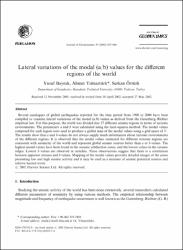Lateral variations of the modal (a/b) values for the different regions of the World

View/
Access
info:eu-repo/semantics/restrictedAccessDate
2002Access
info:eu-repo/semantics/restrictedAccessMetadata
Show full item recordAbstract
Several catalogues of global earthquakes reported for the time period from 1900 to 2000 have been compiled to examine lateral variations of the modal (a/b) values as derived from the Gutenberg–Richter empirical law. For this purpose, the world was divided into 27 different seismic regions in terms of tectonic environments. The parameters a and b were calculated using the least-squares method. The modal values computed for each region were used to produce a global map of the modal values using a grid space of 3 . The results show that a and b-values do not always supply much information about tectonic environments of the different regions. It is observed that the modal values estimated for different tectonic regions are consistent with seismicity of the world and represent global seismic sources better than a or b values. The highest modal values have been found in the oceanic subduction zones, and the lowest values in the oceanic ridges. Lowest b values are observed in trenches. These observations suggest that there is a correlation between apparent stresses and b values. Mapping of the modal values provides detailed images of the zones presenting low and high seismic activity and it may be used as a measure of seismic potential sources and relative hazard levels.
URI
https://hdl.handle.net/20.500.12440/130https://www.sciencedirect.com/science/article/pii/S0264370702000376

















